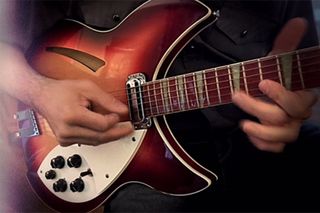
One of the most commonly addressed topics with my students is how one goes about connecting scale positions while playing an improvised solo.
Many guitarists learn licks that are played on certain strings in specific areas of the fretboard. As great as these licks may be, connecting them into a unified solo statement remains, for many players, a mystery, or at least a challenge. In this lesson, I’ll demonstrate how to use chromatic passing tones to connect scale positions up and down the fretboard and how to introduce some unusual and unexpected melodic twists and turns.
Last month, our focus was on how to build rhythm patterns over a static, unchanging harmonic environment, such as Am or Am7. Using the A Dorian mode (A B C D E F# G) as our basis, we formed chord voicings built from stacked fourths and moved up and down the fretboard, all the while remaining diatonic to (within the scale structure of) A Dorian. FIGURE 1 illustrates a 10-bar rhythm part built from shifting stacked-fourths voicings derived from A Dorian.
While playing through this figure, notice how all the notes in each voicing are fourths apart within the structure of A Dorian, and be sure to memorize each of these distinct chord shapes, or “grips.” If you were to traverse the entire fretboard with these types of voicings, you’d discover that there are only four different physical shapes used, and it is helpful to bear this in mind. A serious improviser needs to memorize every scale and mode in every position and key, which is a lot of work!
Unfortunately, there are no shortcuts to gaining a complete understanding and mastery of this. But no matter one’s familiarity with scales and modes all over the fretboard, employing chromatic passing tones is a concept that is as easy to understand as it is to apply. It just comes down to working these chromatic movements into your muscle memory.
FIGURE 2 details the A Dorian mode played in fourth-fifth position. Play this pattern repeatedly in order to memorize it and get it under your fingers. Also, be sure to memorize the Dorian mode’s intervallic structure, or formula, which is 1(root) 2 b3 4 5 6 b7. Let’s look at an example of some soloing over the rhythm part in FIGURE 1 that is based A Dorian, with chromatic passing tones added to facilitate moving from one fretboard position of A Dorian to another.
FIGURE 3 illustrates a five-bar phrase that begins in fifth position and then moves down to fourth position, and then down to second position before winding its way back up to fourth and then fifth position. Rhythmically, the line is built primarily from straight 16th notes articulated with hammer-ons, pull-offs and slides, combined with some alternate picking, in a style influenced by jazz guitarist Pat Martino. Notice the occasional pair of 32nd notes, added to give the phrases extra “bounce.” The first six notes of FIGURE 3 all “live” in A Dorian, but on the second 16th note of beat two, I play an F note between F# and E in order to sound a chromatically descending progression of 16th notes, moving from G to F# to F then E.
The last note in bar 1, G#, is used to set up the subsequent G-to-A movement on beat one of bar 2. Moving into beat three, G# is again used as a chromatic passing tone, allowing me to pivot off of the A root note in different directions. The last note in bar 2, C#, is employed as a chromatic passing tone between D and C, enabling me to shift down to third and then second position. Notice also the low G# note played on beat one of bar 3, which I use to provide a more varied harmonic environment. Moving into beat four, I slide from D to Eb on the A string before crossing over to the D string, a move that enables me to shift up to fretboard to fourth position.
FIGURE 4 offers another five-bar solo. I begin this example with a chromatic slide up from the flatted fifth, Eb, to E, followed by the superimposition of an Em7 arpeggio (E G B D) over the Am tonality. In bar 2, on the last 16th note of beat one, I use G# as a passing tone, and throughout this bar I decided to replace the expected G note with G# and the F# with F in order to tap into the sound of the A harmonic minor scale (A B C D E F G#). Within A harmonic minor, I now have some built-in chromatic movement—between A and G# and between F and E. At the end of bar 2, I use Eb as a chromatic passing tone leading to D and then wind my way down the D string using occasional passing tones, such as G#, Bb and Eb.
FIGURE 5 is based primarily on A harmonic minor and starts higher up the fretboard, in 10th position. On beat two of bar 2, I add Bb as a passing tone between B and A, using G# as a “set-up” to get back to A. This sequence of notes—B, Bb, G#, A—is an example of what’s often referred to as a “surrounding-note figure,” in that the A root note is the target note, and the surrounding notes, Bb and G# (also referred to as upper and lower chromatic neighbors), are played first in order to set up the landing on the A root note squarely on the downbeat of beat three. FIGURE 6 is a four-bar line based on the A symmetrical diminished scale (A Bb C C# D# E F# G). Notice how the notes move up in chromatic pairs—A to Bb, C to C#, D to D#, and so on—with whole steps used between each chromatic pair.




